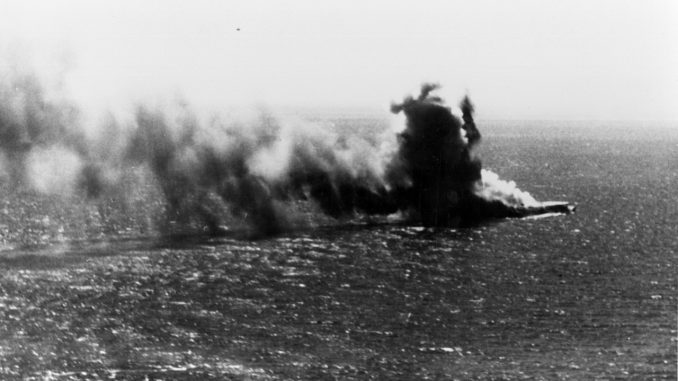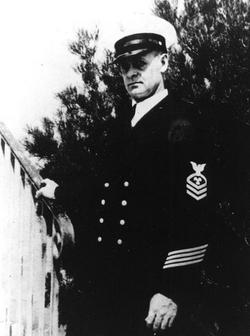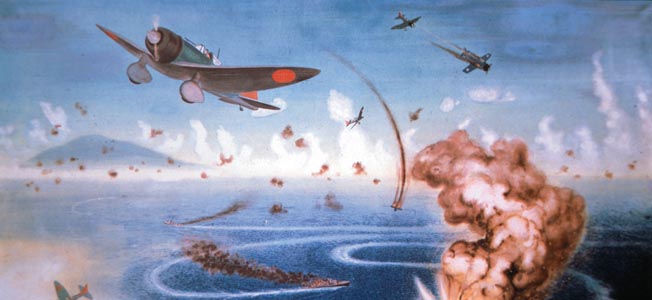5/4/1942 - Deciphered communications provided by the Office of Naval Communications pointing the way, Admiral Chester A. Nimitz decides to blunt Operation Mo, the Japanese plans for empire expansion into the South Pacific, by ordering all four of the carriers he possesses (the USS Lexington, the USS Yorktown, the USS Enterprise, the USS Hornet and their supports ... too far away after supporting the Doolittle Raid on Tokyo, Hornet and Enterprise will miss the clash) ... precipitating five days of action that will come to be known as the Battle of the Coral Sea ... a battle that makes military history for being the first time two fleets battle each other without any of the ships making actual visual contact with an enemy vessel.

Nimitz

USS Lexington - October, 1941

USS Yorktown - July, 1937
In the slugfest that follows, the Japanese will win a tactical victory by sinking more American tonnage than they lose (42,497 tons of American vessels), while America can claim a tactical triumph because the Japanese fleet retreats back to their base at Truk Island and they abandon their plan to invade Port Moresby ... decisions that allow the supply line from the West Coast of the United States to Australia to remain open, and that set the stage for one of the American Navy's finest moments the following month off a speck of Pacific coral and sand called Midway Island. American losses in the battle include the death of the USS Lexington, the USS Yorktown being grievously damaged, the oil tanker USS Neosho going to the bottom, and the destroyer USS Sims going to the bottom ... additionally, 69 planes and 656 men are lost.

The USS Lexington Explodes

The USS Neosho Under Attack

USS Yorktown Undergoing Repairs -
Pearl Harbor, 5/29/1942
On the Japanese side of the ledger are the loss of the light carrier Shoho (becoming one of the Navy's beloved catch phrases to go with stuff like "I have only just begun to fight!", "Don't give up the ship!", and "Damn the torpedoes, full steam ahead!", upon completing the American attacks that hit the Shoho with fifteen 1,000 pound bombs and five torpedoes, Lt. Commander Robert E. Dixon radios home to the USS Lexington, "Scratch one flat top!"), the sinking of the destroyer Kikuzuki, three gunboats being destroyed, the carrier Shokaku being heavily damaged, a destroyer being damaged, two small warships suffering damage, the loss of 92 aircraft and the deaths of 966 Japanese fliers and sailors. It is the first time in the war that a Japanese offensive has been stopped ... a window to what the future.

Shoho Hit

Shoho On Fire
USS Yorktown Planes Attack Shokaku
Cold numbers and names however do not provide the view of a clash that sometimes personal stories do, so for the Battle of the Coral Sea, here are the tales of three typical Americans that endured the Great Depression, and then after the sneak attack on Pearl Harbor, kept the world safe from Hitler, Mussolini, and Tojo ... three winners of the Congressional Mead-of-Honor for bravery for their actions during the battle:
*42-year-old Chief Petty Officer Oscar Verner Peterson of Prentice, Wisconsin ... trying to save the USS Neosho, Peterson is in charge of a repair party that goes down when the tanker is hit by yet another Japanese bomb ... the only man able to rise from his wounds, despite his injuries, Peterson is able to close four bulkhead steam lines that keep the ship operational, but in the process suffers 3rd-degree burns to his face, shoulders, arms, and hands that take the life of the man on 5/13.

USS Neosho On Fire

American Survivors

Peterson
*29-year-old Lieutenant John James Powers of New York City ... from the USS Yorktown, attacking Japanese shipping that has invaded the island of Tulagi in his SBD Dauntless dive bomber, on 5/4, Powers destroys a large enemy gunboat, damages two other craft, and strafes another gunboat so badly that the vessel will be beached the next day ... on 5/7, he drops one of the bombs that sends the Shoho to the bottom ... and on 5/8, knowing the importance of the battle, after lecturing his group the night before on point-of-aim and diving techniques, and telling everyone to go as low as possible before bomb release to insure hits, Powers shows the way, releasing his explosive load on the carrier Shokaku below the recommended safety height (he starts his run at 18,000 feet and releases his bomb at 2,000 feet) ... he is last seen attempting to pull up and away from the carrier at 200 feet above the deck, flying through a sky filled with fire, smoke, and flying bomb and shell fragments.

Powers
Dauntless Flight
Shokaku Under Attack
Shokaku Bow Damage
*28-year-old Lieutenant Milton Ernest Ricketts of Baltimore, Maryland ... at his battle station below decks when Japanese planes hit the USS Yorktown on 5/8, Ricketts is mortally wounded, but manages to rise, open a nearby fire plug, let out a length of hose, and start fighting one of the critical fires that threatens the carrier ... pouring water on the fire, Ricketts eventually falls down dead next to the hose ... but not before he has helped the ship to survive ... and help win the the turning point Battle of Midway in June.

Damaged USS Yorktown

Ricketts
Both sides withdrawing from the area to lick their wounds and prepare for the next round for control of the Pacific, the significance of the clash will not become apparent until the Battle of Midway takes place ... once again, but in an even more devastating manner, code-breakers will give the United States a sneak view of Japanese plans, instead of attacking at Midway with six aircraft carriers, Admiral Yamamoto will go into the clash with only four (Shokaku is forced to go all the way back to Kure, Japan for repair work, and to have the planes and aircrews lost during the battle replaced ... hidden by a rain squall during the battle, Zuikaku escapes damage, but has its air section decimated in defending the Japanese fleet, and in attacking the two U.S. carriers and also goes back to Japan for replacements), and expecting only two U.S. carriers, will be horribly surprised that the USS Yorktown has survived to fight another day (limping north from the Coral Sea, the carrier will arrive for repairs in Pearl Harbor on 5/28 ... given an estimate the work will take two weeks, Admiral Nimitz orders around-the-clock work on the ship, and in a can-do manner, she is once more deemed sea worthy and ready to fight 48 hours later ... and fight she does, though sent to the bottom on 6/7/1942, before the USS Yorktown sinks, her fliers will launch attacks on three of the four Japanese carriers, and will send Soryu to the bottom of the Pacific).

The Hiryu On Fire - Note Blown Open Front Deck
Death Of The USS Yorktown

At Rest
Why today mattered? 5/4/1942 ... it mattered due the fortitude and bravery of the United States Navy's sailors and fliers in stopping the expansion of Imperial Japan during the five days of the Battle of the Coral Sea!
The Battle Of The Coral Sea

The Battle Of The Coral Sea

The Battle Of The Coral Sea
The Battle Of The Coral Sea
No comments:
Post a Comment